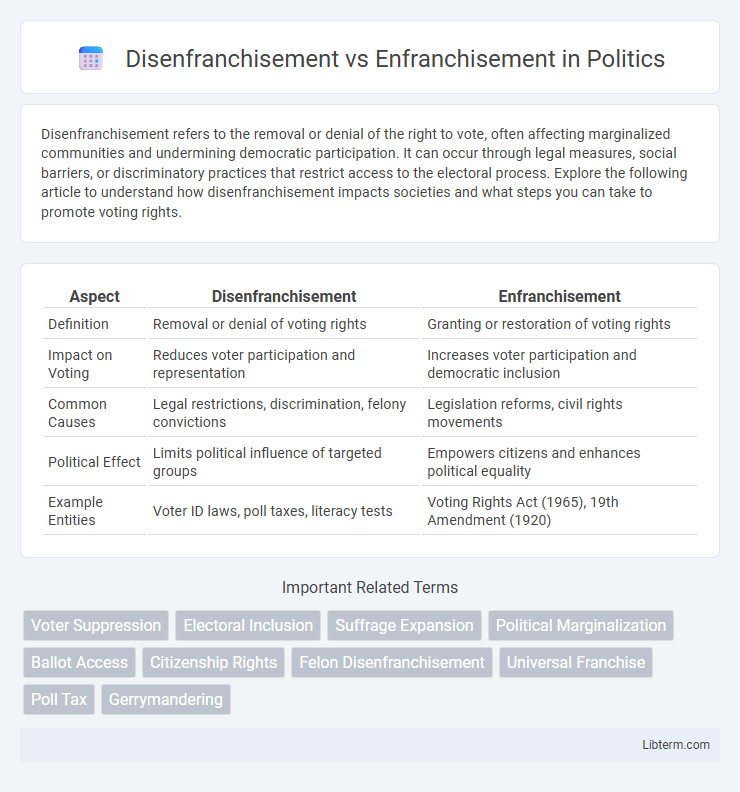Disenfranchisement refers to the removal or denial of the right to vote, often affecting marginalized communities and undermining democratic participation. It can occur through legal measures, social barriers, or discriminatory practices that restrict access to the electoral process. Explore the following article to understand how disenfranchisement impacts societies and what steps you can take to promote voting rights.
Table of Comparison
| Aspect | Disenfranchisement | Enfranchisement |
|---|---|---|
| Definition | Removal or denial of voting rights | Granting or restoration of voting rights |
| Impact on Voting | Reduces voter participation and representation | Increases voter participation and democratic inclusion |
| Common Causes | Legal restrictions, discrimination, felony convictions | Legislation reforms, civil rights movements |
| Political Effect | Limits political influence of targeted groups | Empowers citizens and enhances political equality |
| Example Entities | Voter ID laws, poll taxes, literacy tests | Voting Rights Act (1965), 19th Amendment (1920) |
Introduction to Disenfranchisement and Enfranchisement
Disenfranchisement refers to the systematic denial of voting rights to specific groups, often based on race, gender, or socioeconomic status, leading to unequal political representation and diminished civic participation. Enfranchisement, conversely, involves the extension or restoration of voting rights, empowering marginalized populations and reinforcing democratic principles. Understanding the historical and legal frameworks behind disenfranchisement and enfranchisement highlights ongoing challenges and progress in achieving universal suffrage.
Historical Evolution of Voting Rights
Disenfranchisement historically targeted marginalized groups through mechanisms like poll taxes, literacy tests, and property requirements, significantly restricting voting rights in the United States until the mid-20th century. The enfranchisement movement gained momentum with legislative milestones such as the 15th Amendment (1870), the 19th Amendment (1920), and the Voting Rights Act of 1965, which collectively expanded suffrage and aimed to eliminate racial and gender discrimination in voting. Despite these advances, ongoing legal battles and voter ID laws continue to shape the landscape of voting rights and access.
Causes and Mechanisms of Disenfranchisement
Disenfranchisement arises from legal barriers such as voter ID laws, felony disenfranchisement, and residency restrictions, which systematically exclude specific demographic groups from voting. Socioeconomic factors, including income disparities, limited access to polling places, and educational inequalities, further inhibit voting participation and amplify disenfranchisement. Mechanisms like gerrymandering, purging voter rolls, and restrictive registration processes create structural obstacles that diminish electoral representation and political power for marginalized communities.
Impact of Disenfranchisement on Society
Disenfranchisement significantly reduces political participation by excluding certain groups from voting, undermining democratic legitimacy and perpetuating social inequalities. This exclusion often correlates with systemic marginalization, disproportionately affecting minorities and low-income populations, which exacerbates social fragmentation and distrust in governance. The resulting lack of representation skews policy outcomes, reinforcing cycles of poverty and limiting societal progress.
Enfranchisement: Meaning and Significance
Enfranchisement refers to the granting of voting rights or other privileges to individuals or groups, enabling active participation in democratic processes and civic duties. It plays a critical role in promoting political equality, social inclusion, and empowerment by allowing previously excluded populations to influence government decisions and policies. Understanding enfranchisement highlights its significance in advancing civil rights and fostering a more representative and accountable governance system.
Key Milestones in Global Enfranchisement
Key milestones in global enfranchisement include the 15th Amendment to the U.S. Constitution in 1870, granting African American men the right to vote, and the Representation of the People Act 1918 in the United Kingdom, which extended suffrage to women over 30. The Universal Declaration of Human Rights in 1948 recognized voting as a fundamental right worldwide, influencing numerous countries to abolish discriminatory practices causing disenfranchisement. Landmark events such as the Civil Rights Movement in the 1960s led to the Voting Rights Act of 1965, ensuring enforcement of voting rights and significantly reducing disenfranchisement in the United States.
Comparative Analysis: Disenfranchisement vs Enfranchisement
Disenfranchisement removes voting rights, primarily affecting marginalized groups through legal, social, or economic barriers, resulting in reduced political participation and representation. Enfranchisement, by contrast, grants voting rights and fosters inclusive democracy, empowering individuals and enhancing civic engagement across diverse populations. Comparative analysis highlights that disenfranchisement leads to systemic inequality and diminished democratic legitimacy, whereas enfranchisement promotes social equity and strengthens democratic institutions.
Modern-Day Challenges to Universal Suffrage
Disenfranchisement in modern democracies often arises through voter ID laws, felony disenfranchisement, and gerrymandering, which systematically restrict access to voting for marginalized groups. Enfranchisement efforts focus on expanding voter registration, absentee ballot access, and restoring voting rights after incarceration to ensure broader participation. These challenges highlight ongoing barriers to universal suffrage despite constitutional protections aimed at securing equal voting rights for all citizens.
Legal Frameworks Protecting Voting Rights
Legal frameworks protecting voting rights address disenfranchisement by prohibiting discriminatory practices such as racial, gender, or age-based restrictions that undermine enfranchisement. Key legislations like the Voting Rights Act of 1965 enforce equal access to voting by eliminating barriers like literacy tests and poll taxes. Courts continuously interpret these laws to expand enfranchisement and rectify disenfranchisement caused by restrictive state policies or voter suppression tactics.
Future Directions in Expanding Enfranchisement
Future directions in expanding enfranchisement include implementing automatic voter registration systems and lowering voting age to increase political participation among youth. Efforts to restore voting rights for disenfranchised populations, such as formerly incarcerated individuals, emphasize equitable access to democracy. Technology-driven solutions like secure online voting platforms aim to remove logistical barriers and enhance accessibility for diverse demographics.
Disenfranchisement Infographic

 libterm.com
libterm.com